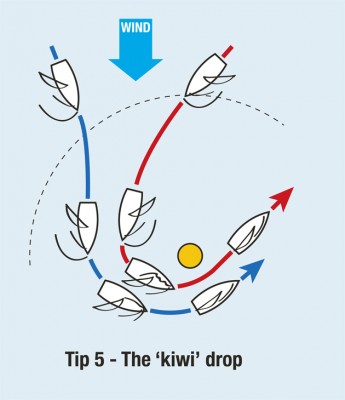All the good work of the first lap can be undone at the leeward mark. Jonty Sherwill asked coach Mark Rushall for his 5 tips on how to avoid disaster
You’ve been catching the boat ahead since the top mark and their tactician is now screaming ‘no overlap’ as you thunder towards the three-boat zone on port gybe. There’s no escape route, another boat close behind is hoping for a last-minute overlap to leeward and a boat on starboard is coming in from the left. With the mark straight ahead your helmsman is now unsighted as the masthead asymmetric heads down the open forehatch, so a cool nerve and some luck will be needed to get round cleanly.
So what could you have done better to avoid this mess? In these situations a good knowledge of the rules and clear instructions from the back end of the boat will allow a crew time to prepare for the drop and rounding, whereas asking for ‘one and in’ at the last moment, having missed a layline, can be the start of a big unravelling with unpredictable consequences.
Leeward mark rounding in a competitive one-design fleet can be a humbling experience, but when a mix of boats is arriving at different speeds and angles it can be even tougher to work out who’s going to get there and when.
Learning to read situations as they develop comes through practice, but with some expert advice you can be on the fast track to making big gains at the bottom end of the course.
1. Begin with the end in mind
What are the priorities for the next leg? Get in phase with the oscillating shifts? Hold a lane to the advantaged side? Get onto the ‘long tack’ as soon as possible? The answers to these questions should shape your positioning against other boats on the leeward mark approach.
For an early tack, avoid being overlapped outside another boat at the mark: drop early, weave around if necessary to break the overlap and exit tight on the mark so following boats cannot pin you out.
If you are making a charge for the left hand side (in a port hand rounding), a tight rounding is only necessary if there are boats close ahead: a smooth arc gives better VMG.
2. Understand Rule 18
The rules of Section C of RRS Part 2 don’t take over from the ‘right of way’ rules: they just add some extra obligations to a boat that was overlapped or clear astern of a boat at the zone. An inside right of way boat can generally push for the classic ‘wide in, tight out’ rounding: a keep clear boat cannot if the right of way boat is close outside. If there is doubt about whether there was an overlap at the zone, the protest committee will go back to the last point of certainty.
3. Pick the right gate mark
If one mark appears favoured, ask yourself why. If it is due to an oscillation, the only way to bank any apparent gain would be to tack immediately; this may not be possible. The boats rounding the ‘unfavoured’ mark will get straight in phase, and cross you on the next shift.
Depending on leg length, if you are three-quarters of the way down the run and you can’t tell which one is favoured, there is almost certainly something more important to think about. Go back to point 1 and chose the mark that is going to get you on the tack you want.
4. Think ahead
Plan the drop around the next offwind leg: swinging the gear three-quarters up the beat is distracting and SLOW! Practise stowing the pole early. Communicate the plan clearly – the pole will definitely be stowed under the windward jib sheets, the leeward in-hauler and jib and main travellers prepared, if everyone knows what’s happening.
Hoist the jib part-way in plenty of time to avoid last-minute fumbles, check the conditions early and get everything onto its mark well before the rounding – nothing is more frustrating than a saggy jib luff or in-haulers that need adjusting at the most important part of the beat when weight on the rail is at its most critical.
5. Use the angles
When asymmetric sailing, a Kiwi drop (gybe drop) inside the zone guarantees an overlap on any boats approaching on the other gybe. Aim to hit the zone directly to windward of the mark and be prepared to slow down by sailing extra deep to give a little extra time.
But avoid overshooting the layline at the last gybe in, it’s easy to do. If a gust then forces you down to or below the layline on the final approach, the Kiwi manoeuvre will be almost unachievable for the crew.
Mark Rushall is one of the UK’s leading sailing coaches, a yachting journalist and author, and a successful sailor, with many national and international dinghy titles to his name. He is now in his third Olympiad as a member of the British Sailing Team, coaching development squads and individuals.
This is an extract from a feature in the May 2015 issue of Yachting World







